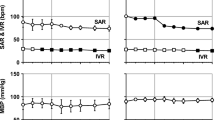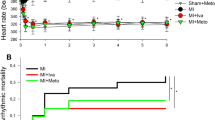Summary
Myocardial infarction was produced in 27 anesthetized dogs by ligating the left anterior descending (LAD) coronary artery proximal to the septal branch. Nineteen of these animals survived the operation and were studied by programmed stimulation in a random sequence between the third and seventh days after the infarct. Complete electrophysiologic testing was implemented in each animal prior to and after single doses of either alinidine (1 mg/kg IV) or zatebradine (0.5 mg/kg IV). Alinidine prevented reinduction of sustained ventricular tachycardia (SVT) in only 2 of 9 dogs and zatebradine in 1 of 8 dogs. The SVT cycle length was not significantly changed in all cases in which it was still inducible despite drug administration (p>0.05). Alinidine lengthened the effective refractory period (ERP) in the AV node (p<0.01), whereas zatebradine did not induce a statistically significant prolongation. Conversely, zatebradine increased the left ventricular ERP, while alinidine left it almost unchanged. The rate-corrected QT interval (QTc) did not significantly differ from control values after the administration of either agents. Also, the duration and the ERP of infarctzone potentials, defined as late potentials, remained unaltered. The results indicate that the bradycardic agents alinidine and zatebradine do not exert antiarrhythmic efficacy against SVT induced during subacute myocardial infarction in conscious dogs. None of these drugs substantially changed ventricular electrophysiology or showed a drug-specific proarrhythmic effect.
Similar content being viewed by others
References
Hope RR, Williams DO, El-Sherif N, Lazzara R, Scherlag BJ. The efficacy of antiarrhythmic agents during acute myocardial ischemia and the role of heart rate.Circulation 1974;50:507–514.
Norris RM, Mercer CJ, Yeates SE. Sinus rate in acute myocardial infarction.Br Heart J 1972;34:901–908.
Kent KM, Smith ER, Redwood DR, Epstein SE. Electrical stability of acutely ischemic myocardium: Influences of heart rate and vagal stimulation.Circulation 1973;47:291–298.
Chadda KD, Banka VS, Helfant RH. Rate dependent ventricular ectopia following acute coronary occlusion: The concept of an optimal antiarrhythmic heart rate.Circulation 1974;49:654–658.
Lederman SN, Wenger TL, Harrell FE, Strauss HC. Effects of different paced heart rates on canine coronary occlusion and reperfusion arrhythmias.Am Heart J 1987;113:1365–1369.
Spear JF, Moore EN. The effect of changes in rate and rhythm on supernormal excitability in the isolated Purkinje system of the dog.Circulation 1974;50:1144–1149.
Brachmann J, Aidonidis I, Dembowsky K, Seller H, Kübler W. Bepridil versus nifedipine for ventricular tachycardia induced in the late postinfarction phase in conscious dogs.Cardiology 1989;76:211–221.
Uprichard AC, Chi LG, Lynch JJ, Driscoll EM, Frye JW, Lucchesi BR. Alinidine reduces the incidence of ischemic ventricular fibrillation in a conscious canine model, a protective effect antagonized by overdrive atrial pacing.J Cardiovasc Pharmacol 1989;14:475–482.
Raberger G, Krumpl G, Schneider W, Mayer N. Effects of specific bradycardic agents on exercise-induced regional myocardial dysfunction in dogs.Eur Heart J 1987;8 (Suppl L):53–59.
Krumpl G, Schneider W, Raberger G. Can exercise-induced regional contractile dysfunction be prevented by selective bradycardic agents?Naunyn Schmiedebergs Arch Pharmacol 1986;334:540–543.
Harris AS. Delayed development of ventricular ectopic rhythms following experimental coronary occlusion.Circulation 1950;1:1318–1328.
El-Sherif N, Scherlag BJ, Lazzara R, Hope RR. Re-entrant ventricular arrhythmias in the late myocardial infarction period: I. Conduction characteristics in the infarction zone.Circulation 1977;55:686–702.
Walker MJA, Curtis MJ, Hearse DJ, et al. The Lambeth Conventions: Guidelines for the study of arrhythmias in ischemia, infarction, and reperfusion.Cardiovasc Res 1988;22:447–455.
Aidonidis I, Brachmann J, Seller H, Dembowsky K, Czachurski J, Kübler W. Cardiac sympathetic nervous activity during myocardial ischemia, reperfusion, and ventricular fibrillation in the dog: Effects of intravenous lidocaine.Cardiology 1992;80:196–204.
Aidonidis I, Egel E, Hilbel T, Kübler W, Brachmann J. Effects of prenylamine and AQ-A 39 on reentrant ventricular arrhythmias induced during the late myocardial infarction period in conscious dogs.J Cardiovasc Pharmacol 1993;22:401–407.
Bazett HC. An analysis of the time-relations of electrocardiograms.Heart 1920;7:353–370.
Janse MJ, Kleber AG, Downar E, Durrer D. Changements electrophysiologiques pendant l'ischemie myocardique et mecanisme possible des troubles du rythme ventriculaire.Ann Cardiol Angeiol Paris 1977;26:551–554.
van-Bogaert PP, Goethals M. Pharmacological influence of specific bradycardic agents on the pacemaker current of sheep cardiac Purkinje fibres: A comparison between three different molecules.Eur Heart J 1987;8(Suppl L):35–42.
van-Ginneken AC, Bouman LN, Jongsma HJ, Duivenvoorden JJ, Opthof T, Giles WR. Alinidine as a model of the mode of action of specific bradycardiac agents on SA node activity.Eur Heart J 1987;8(Suppl L):25–33.
Satoh H, Hashimoto K. Electrophysiological study of alinidine in voltage clamped rabbit sino-atrial node cells.Eur J Pharmacol 1986;121:211–219.
Tritthart HA, Windisch H, Heuberger S. The effects of the bradycardia-producing compound alinidine on action potentials and tension development in cardiac fibres.Naunyn Schmiedebergs Arch Pharmacol 1981;316:172–177.
Harron DWG, Allen JD, Wilson R, Shanks RG. Effect of alinidine on experimental cardiac arrhythmias.J Cardiovasc Pharmacol 1982;4:221–225.
Schamhardt HC, Verdouw PD, Saxena PR. Improvement of perfusion and function of ischaemic porcine myocardium after reduction of heart rate by alinidine.J Cardiovasc Pharmacol 1981;3:728–738.
Verdouw PD, Saxena PR, Schamhardt HC, Van der Hoek TM, Rutteman AM. The effects of alinidine, an N-allyl derivative of clonidine, on regional myocardial perfusion and performance in the pig with or without atrial pacing.Eur J Pharmacol 1980;64:209–220.
Rouse W, Johnson IR. Haemodynamic actions of a novel sino-atrial node function modulator, ZENECA ZD7288, in the anesthetized dog: A comparison with zatebradine, atenolol and nitrendipine.Br J Pharmacol 1994;113:1064–1070.
Wiegand V, Kreuzer H. Acute haemodynamic effects of a specific bradycardic agent in patients with coronary heart disease and impaired left ventricular function.Eur Heart J 1987;8(Suppl 8):105–108.
Jaski BE, Serruys PW. Anion-channel blockade with alinidine: A specific bradycardic drug for coronary heart disease without negative inotropic activity?Am J Cardiol 1985;56:270–275.
König W, Stauch M, Sund M, Wanjura D, Henze E. Hemodynamic effects of alinidine (ST 567) at rest and during exercise in patients with chronic congestive heart failure.Am Heart J 1990;119:1348–1354.
Brutsaert DL, De Clerck NM, Stanlas US. Activation stabilization: Further support for a new class of cardioactive substances.J Cardiovasc Pharmacol 1982;4:808–811.
Traunecker W, Walland A. Haemodynamic and electrophysiologic actions of alinidine in the dog.Arch Int Pharmacodyn 1980;244:58–72.
Van Woerkens LJ, Van der Giessen WJ, Verdouw PD. The selective bradycardic effects of zatebradine (UL-FS 49) do not adversely affect left ventricular function in conscious pigs with chronic coronary artery occlusion.Cardiovasc Drugs Ther 1992;6:59–65.
Pichler L. Effect of alinidine (St 567) on sympathetic and vagal activities.Arch Int Pharmacodyn 1982;255:162–167.
Boucher M, Chapuy E, Lefebvre MA, Mignot A, Duchene-Marullaz P. Mechanisms of chronotropic cardiac effects of alinidine and plasma concentration-response relationships in the conscious dog with chronic atrioventricular block.Naunyn Schmiedebergs Arch Pharmacol 1989;339:630–637.
Hondeghem LM, Snyders DJ. Class III antiarrhythmic agents have a lot of potential but a long way to go: Reduced effectiveness and dangers of reverse use dependence.Circulation 1990;81:686–690.
Algra A, Tijssen JGP, Roelandt JRTC, Pool J, Lubsen J. Heart rate variability from 24-hour electrocardiography and the 2-year risk for sudden death.Circulation 1993;88:180–185.
Bolli R, Patel B. Factors that determine the occurrence of reperfusion arrhythmias.Am Heart J 1988;115:20–29.
Pouleur H. Calcium antagonists or beta-blockers in chronic ischaemic left ventricular dysfunction?Eur Heart J 1993;14(Suppl F):26–28.
El-Sherif N, Hope RR, Scherlag BJ, Lazzara R. Re-entrant ventricular arrhythmias in the late myocardial infarction period. 2. Patterns of initiation and termination of re-entry.Circulation 1977;55;702–717.
Garan H, Fallon JT, Ruskin JN. Sustained ventricular tachycardia in recent canine myocardial infarction.Circulation 1980;62:980–987.
Thollon C, Cambarrat C, Vian J, Prost JF, Peglion JL, Vilaine JP. Electrophysiological effects of S 16257, a novel sino-atrial node modulator, on rabbit and guinea-pig preparations: Comparison with UL-FS 49.Br J Pharmacol 1994;112:37–42.
Author information
Authors and Affiliations
Rights and permissions
About this article
Cite this article
Aidonidis, I., Brachmann, J., Rizos, I. et al. Electropharmacology of the bradycardic agents alinidine and zatebradine (UL-FS 49) in a conscious canine ventricular arrhythmia model of permanent coronary artery occlusion. Cardiovasc Drug Ther 9, 555–563 (1995). https://doi.org/10.1007/BF00878087
Received:
Accepted:
Issue Date:
DOI: https://doi.org/10.1007/BF00878087




